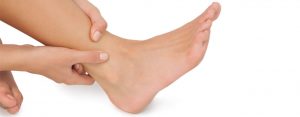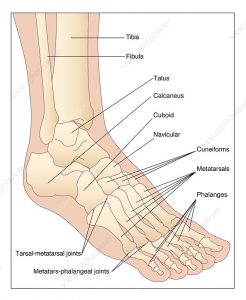“The game is going on fiercely. Players from both sides come and go. A player kicks the ball forward, encounters obstacles, quickly pass the ball, seeing the ball is about to return to his feet, suddenly he staggers, and he falls to the ground in an instant. With a painful expression, pressing his ankle with his hand…”
Football is a high-intensity and strenuous exercise. Football players need to use a strong ankle when running at high speed, lobbing, and kicking the ball. It is easy to sprain or break the ankle ligaments.
Research reports show that among the sports injuries of football players, the ankle joint is the most common (incidence rate of 16 to 29%). When a football player suffers from an acute ankle ligament sprain during the game season, the minor ones have undergone acute care treatment, taped and fixed, and there may be a chance to play. The severe ones may be reimbursed throughout the entire season, especially for those who have suffered once every four years. For football players who have worked hard to practice in the World Cup, it is even more painful for a lifetime!
In fact, in addition to athletes, most people accidentally step on the air or jump from a height when walking, it is also easy to cause ankle sprains. The most frequently heard complaints from patients: “Why does my ankle sprain always fail to heal? It’s easy to relapse” and it is even hard to guarantee that there will be no problems when walking on a flat road.
Acute treatment and treatment of ankle sprain
Acute ankle ligament injury, you should master the “RICE (rest, ice, compression, elevation)” golden rule:
‧Stop walking as soon as possible, rest the injured part, and do not step on the ground (use the underarm crutches to support it) to raise it.
‧Hurry up and apply ice at the same time, once every 2 hours, once for 10-15 minutes, and apply a fixed compression. You can use an elastic bandage, from the toe from the bottom up, and fix it to the ankle above the ankle in a figure-eight spiral.

The use of non-steroidal anti-inflammatory drugs in the acute phase can reduce inflammation and pain, and help subsequent tissue repair; do not vigorously massage, to avoid local inflammation and swelling.
Ankle sprains can range from inflammation and swelling of the ligament tissue to partial lacerations, or even complete rupture, depending on the severity. Doctors can make a detailed diagnosis through a high-resolution ultrasound examination of the musculoskeletal system; if necessary, X-ray examination can see avulsion fractures. The most common site is the end of the fifth finger metatarsal.
However, the current treatment concept is that if the surgical suture will affect joint mobility and muscle strength reconstruction, even if the ligament is completely broken, most of them still adopt conservative treatment, that is, active rehabilitation; unless there is a serious tear fracture, plaster fixation is required. 4~6 weeks.
The sprained ankle has a very high recurrence rate
Sprains of the lateral ankle are the most common. They usually occur when the toes go down and the toes go inwards, that is, the movement of kicking the top of the football with the toe board. The recurrence rate is as high as 50% or more, and many of them even become chronic ankle pain and degenerative arthritis.
In the rehabilitation clinic, many sports-loving people with sprained ankles will ask: “How long do I have to rest without exercising?” I often tell them that sprains of ankle ligaments are not “rest without exercise”. Take good treatment, in addition to correct treatment in the acute phase (RICE), and rehabilitation during the recovery period (such as the following 3 types of therapeutic exercises), to say goodbye to the dream of repeated ankle sprains.
Sequelae of ankle sprain and rehabilitation treatment

Insufficient ankle mobility
A normal ankle joint must be able to go up, down, turn in (foot down, toes facing in), and eversion (foot up, toes facing out). After the acute inflammation and swelling are improved, you must work hard to restore the ankle angle to completely normal.
Try to write Arabic numerals in the air with your ankles, and try to stretch the tendons for tight spots. Lunge forward and backward, knee straight, knee bent, which can be extended to the posterior calf muscles and Achilles tendon respectively.
Poor ankle stability, insufficient muscle strength
Partial laceration or complete rupture of the ligament will affect the stability of the ankle joint. Repetitive lateral ankle ligament sprains are often associated with insufficient ankle valgus muscle strength. As long as there is the pulling force of the inversion action, it is easy to be injured again, making the joint stability worse. Therefore, after the acute phase, the strengthening of muscle strength is very important.
Use elastic bands to perform resistance exercises of the ankle joint, from sitting to standing, gradually increasing the challenge.

Foot bones, artwork. The toes are made up of the phalanx bones (phalanges), two for the big toe (right) and three for the others. Metatarsal bones in the mid-foot link the phalanges to the tarsal bones. The tarsal bones include the calcaneus bone (heel) and the talus. These bones articulate with the lower leg bones, the fibula and tibia (shin bone), to form the ankle.
Poor ankle balance control
In the state of ankle sprain, if the injured foot is behind and the normal foot is in front, the two feet are connected, and the center of gravity is shifted back, the body will shake obviously, which represents the joint position sense (JPS) of the ankle joint. Influence. Don’t underestimate this problem. The sense of balance has not been fully restored. Once it touches a little bump on the ground, it is easy to get injured again.
Stand on one foot, use the activity of the other foot to generate the center of gravity displacement, provide sensory feedback stimulation or balance board (BAPS) can be used as balance training.
And for athletes to return to the court, these three standards will be higher, including having to jump forward and sideways with one foot, quickly descend the stairs, sprint (quickly sprint, suddenly stop and then back), “8” half There is no problem running as fast as you can at full speed before you can return to normal training and competition.
Hot blogs:
The Easiest Custom Insoles: Heat Moldable Insoles
Custom insoles, also known as orthotic insoles, are designed to provide personalized support and comfort for individuals with various foot conditions. In [...]
Children’s Insole Size Conversion Chart
The standard sizes for shoe insoles may vary from country to country, making it a headache to choose the right insole for [...]
Do custom orthotics need to be made by a doctor personally?
Custom orthotics do not necessarily need to be made by a doctor personally. While doctors, specifically podiatrists or orthopedic specialists, are often [...]
Do NBA players use custom insoles?
Custom insoles are not only helpful for people with foot health issues, but they also play a significant role in targeting the [...]
